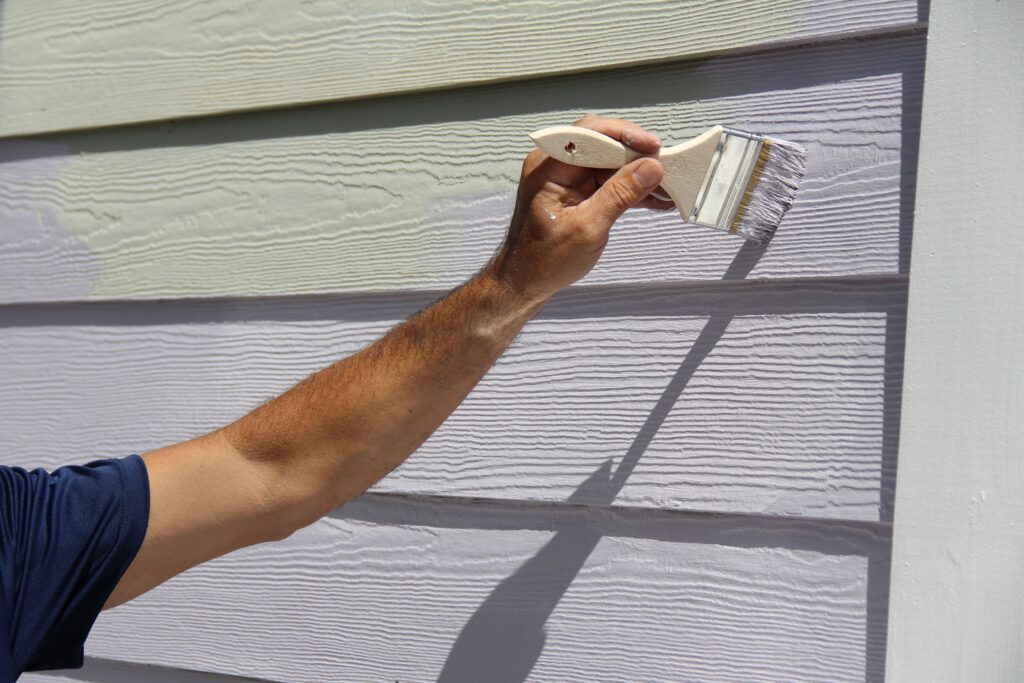Preparation: Begin by thoroughly cleaning the vinyl surface with soap and water to remove dirt and grime. Once dry, sand lightly with 220-grit sandpaper to help the primer and paint adhere better. Wipe away dust with a tack cloth.
Primer Application: Apply a high-quality primer that’s suitable for vinyl. This can be either a spray-on or brush-on type. Let it dry for the time recommended by the manufacturer.
Painting: Use a paint specifically designed for vinyl surfaces. Apply the paint in thin, even coats, allowing each coat to dry fully before applying the next.
Finish: If desired, apply a clear coat finish for additional protection. Make sure the finish is compatible with your paint.
Drying: Allow the paint to dry fully before reassembling or using the painted vinyl item. Drying times can vary greatly depending on the type of paint and the environmental conditions.
By following these steps, you can successfully refresh and update old, faded, or outdated vinyl items, giving them a new lease of life.
SECTION TAKEAWAY
- While it is technically possible to paint vinyl siding for a refreshed look, it’s a complex decision that comes with considerations, such as the potential reduction of the siding’s lifespan and the paint’s susceptibility to chipping and peeling. Options like replacing the siding or restoring it through professional cleaning and sealing could be more cost-effective and beneficial in the long run, preserving the siding’s integrity and potentially delivering more aesthetic and financial value to the homeowner.
Vinyl siding has become a popular choice for homeowners due to its low maintenance and durability. However, over time, the color of vinyl siding can fade or become outdated. This leads many homeowners to wonder: can you paint vinyl siding? The answer to this question is not as simple as a ‘yes’ or ‘no.’ In this article, we will explore the various aspects of painting vinyl siding and provide you with all the information you need to make an informed decision.
The Debate: Can You Paint Vinyl Siding?
The debate surrounding vinyl siding and painting has been ongoing for years. Many homeowners have asked the question “Can you paint vinyl siding?” and the answer is yes, you can. Painting vinyl siding is a great way to add a fresh look to your home and protect it from the elements. However, there are some considerations to take before attempting to paint your vinyl siding. You should always use paint that is specifically designed for vinyl siding, as this will ensure the best results. In addition, you should also make sure to properly prepare the surface before painting and follow all instructions for the paint you are using. With the right preparation and paint, you can easily transform the look of your home and increase its value.
When it comes to improving the look of your home, painting vinyl siding is often seen as an attractive option. However, there are some potential drawbacks to consider before deciding to paint your vinyl siding. One of the major cons is that painting can reduce the lifespan of your siding. Since vinyl is designed to last for many years, painting it may reduce its lifespan and it may need to be replaced sooner than expected. Additionally, paint can chip and peel over time, leading to an unsightly appearance. Finally, painting vinyl siding can be quite difficult and time-consuming, especially if you are not experienced in painting. For this reason, it is often best to hire a professional to do the job.
If you’ve decided to take on the task of painting your vinyl siding yourself, make sure to follow these steps to ensure you have beautiful, freshly painted siding in no time:
Should You Paint Your Vinyl Siding?
We’ve answered whether you can paint your vinyl siding, but the more important question is whether you should paint your vinyl siding. There are 2 options on the table instead of painting vinyl siding: replacing vinyl siding or cleaning and restoring vinyl siding:
Replacing Vinyl Siding:
When it comes to improving the curb appeal of your home’s exterior, you have two popular options: replacing vinyl siding or painting it. Replacing vinyl siding is usually a more expensive and labor-intensive procedure than simply painting it. Painting vinyl siding is typically less expensive and requires fewer materials, making it a more cost-effective solution. Although the initial cost of replacing the siding may be greater than painting it, the increased longevity and improved appearance of the home may make it a worthwhile investment. However, it is important to remember that painting vinyl siding is not a permanent fix and the paint may fade or chip over time, necessitating frequent touch-ups. Whether you choose to replace or paint your vinyl siding, it’s important to determine the best solution for your budget and your needs.








SIDING VISUALIZER TOOL
Design A Home In 5 Minutes
Help your homeowners visualize new siding and colors on their own home with Renoworks’ AI technology in seconds.
- Easy-to-use interface designed for contractors and professionals working with homeowners.
Vinyl Siding Cleaning and Restoration
Vinyl siding cleaning and restoration is the other alternative to painting and can be a more cost-effective and efficient solution for homeowners looking to improve the look of their vinyl siding. It involves cleaning the siding with a power washer, then applying a special cleaning solution that will help remove dirt, mold, and mildew. After the solution has been applied, it is then rinsed off and allowed to dry. Once the siding is dry, a sealant is applied to protect the siding from future dirt and grime. This process can help restore the original look of the siding, and it can be much more cost-effective than painting. Additionally, it can help preserve the long-term life of the siding, saving you the trouble and expense of replacing it.
SECTION TAKEAWAY
- The key to a successful and long-lasting paint job on vinyl siding is choosing high-quality exterior paint specifically designed for vinyl surfaces, considering factors such as adhesion, UV protection, and flexibility to withstand the siding’s expansion and contraction. It’s also vital to select a paint color that complements your home’s style and to choose a reliable paint manufacturer, with Sherwin-Williams, Benjamin Moore, and Behr being top contenders due to their products’ coverage, durability, and mildew resistance.
The Process of Painting Vinyl Siding
If you have decided to paint your vinyl siding, it’s crucial to follow the correct process to ensure a successful outcome. Let’s break down the process into two essential steps: choosing the right paint and step-by-step application.
Choosing the Right Paint for Vinyl Siding
The key to a long-lasting and aesthetically pleasing paint job on vinyl siding is choosing the right paint. It’s essential to select a high-quality exterior paint specially formulated for vinyl surfaces. Look for paints that provide excellent adhesion, UV protection, and flexibility to withstand the expansion and contraction of the siding.
Vinyl siding paint colors can be a great way to give your house a unique and stylish makeover. There are a variety of colors available for vinyl siding, ranging from classic whites and grays to bold and vibrant hues. When choosing a paint color for your vinyl siding, it’s best to keep the style of your home in mind. If you have a more traditional home, you may want to stick with lighter or more muted colors. For a more modern look, you can choose a more vibrant color that will stand out. No matter what color you choose, it’s important to use a quality paint designed specifically for vinyl siding to ensure the best coverage and protection.
Examples of Popular Vinyl Siding Colors:
- Classic Whites and Grays: These colors can provide a timeless look for your home. Popular whites and grays for vinyl siding include shades like Oyster White, Stone Gray, and Slate Gray.
- Bold and Vibrant Hues: If you’re looking for something with a little more personality, you can choose a bolder color such as Navy Blue, Scarlet Red, or Hunter Green.
- Neutral Tones: If you prefer a more neutral look, you can choose colors like Beige, Tan, or Light Gray. or Brown
- Accent Colors: If you want to add a bit of flair to your home, you can choose an accent color like Burgundy, Sage Green, or Yellow. Lately Blues have been a popular accent color as well. Goes very well with grays
Additionally, consider the climate in your area. If you live in an area with extreme temperature variations or high levels of sunlight, choose a paint that offers superior resistance to fading and cracking. UV protection is crucial to prevent the color from fading over time and to maintain the vibrancy of your vinyl siding.
Choosing a Vinyl Siding Paint Manufacturer: The Top Contenders
Deciding on a paint manufacturer for your vinyl siding project can be daunting, but these three popular manufacturers have you covered.
Sherwin-Williams tops the list with some of the most reliable paints for vinyl siding. Its SuperPaint, Duration, and Emerald lines are highly regarded for their excellent coverage, mildew resistance, and ability to retain vibrant color. User-friendly and available in a broad color spectrum, these paints make transforming your vinyl siding a breeze.
Benjamin Moore is another solid contender. Their Aura, Regal Select, and Natura lines are designed to provide superior coverage, resistance to fading, and protection against mildew. Available in a myriad of colors, Benjamin Moore’s high-quality paints offer the perfect opportunity to rejuvenate your home’s exterior.
Rounding out our top three is Behr, a market leader renowned for superior coverage, durability, and fade resistance. Behr’s Premium Plus Ultra, Marquee, and Exterior lines offer popular options for vinyl siding projects. Notably, these paints deliver a long-lasting, mildew-resistant finish, making them ideally suited for outdoor applications.
Finally, if you’re looking for an alternative, consider James Hardie. They offer primed and painted products specifically designed to endure the test of time, providing a lasting solution for your vinyl siding needs.








SIDING VISUALIZER TOOL
Design A Home In 5 Minutes
Help your homeowners visualize new siding and colors on their own home with Renoworks’ AI technology in seconds.
- Easy-to-use interface designed for contractors and professionals working with homeowners.
Step-by-Step Guide to Painting Vinyl Siding
- Preparation is key – Start by thoroughly cleaning the vinyl siding to remove dirt, grime, and any loose paint. Use a mild detergent and a soft brush or sponge to avoid damaging the surface. Rinse it thoroughly and allow it to dry completely.
- Before starting the cleaning process, make sure to inspect the siding for any signs of damage or areas that need repair. Fix any cracks, holes, or loose pieces before proceeding with the painting process. This will ensure a smooth and even application of paint.
- Consider using a pressure washer to clean the vinyl siding effectively. The high-pressure water stream can remove stubborn stains and dirt, leaving the surface ready for painting. However, be cautious when using a pressure washer, as excessive pressure can damage the siding.
- Protect surrounding surfaces – Cover nearby plants, windows, and any other surfaces you don’t want to be painted with plastic drop cloths or painter’s tape.
- When covering plants, make sure to use breathable materials that allow air circulation. This will prevent moisture buildup and potential damage to your plants. Use stakes or supports to create a protective barrier around delicate plants, ensuring that the drop cloths don’t come into direct contact with them.
- Apply a primer – While priming is not always necessary, it can improve adhesion and provide a better base for the paint. If you decide to use a primer, choose one that is formulated for use on vinyl surfaces.
- Before applying the primer, make sure the surface is clean and dry. Use a paintbrush or roller they could also use a sprayer on this step for a smooth base coat to apply a thin and even coat of primer to the vinyl siding. Allow it to dry according to the manufacturer’s instructions before proceeding with the paint application.
- Painting the siding – Start by applying the paint to the surface using a brush, roller, or sprayer. Work in small sections, applying thin and even coats. Allow each coat to dry completely before applying the next one.
- When using a brush, choose one with synthetic bristles that are designed for use with latex paint. This will ensure smooth and even application. For larger areas, consider using a roller or sprayer to expedite the process.
- Pay attention to the direction of the siding when applying the paint. Follow the natural lines and grooves to achieve a seamless finish. Take your time and be patient, ensuring that each coat is evenly applied and free from drips or streaks.
- Finishing touches – Once you have finished painting the entire surface, inspect it for any imperfections or touch-ups that need to be done. Let the paint cure according to the manufacturer’s instructions before considering any maintenance or cleaning.
- After the paint has dried, step back and evaluate the overall appearance of your vinyl siding. Look for any areas that may require additional coats or touch-ups. Use a small brush to fix any imperfections, ensuring a flawless finish.
- Once you are satisfied with the outcome, resist the temptation to immediately clean the surface. Allow the paint to cure fully before engaging in any maintenance or cleaning activities. This will ensure that the paint adheres properly and maintains its durability over time.
- Apply a coat of sealant to the siding to help protect it from fading and weathering.







SIDING VISUALIZER TOOL
Design A Home In 5 Minutes
Help your homeowners visualize new siding and colors on their own home with Renoworks’ AI technology in seconds.
- Easy-to-use interface designed for contractors and professionals working with homeowners.
SECTION TAKEAWAY
- Maintaining painted vinyl siding requires regular cleaning with mild soap and water, along with the use of a pressure washer for tougher grime, all while taking care not to damage the siding. It’s also vital to apply a coat of sealant or primer post-washing to protect the siding from fading and weathering, routinely inspect for potential damage, especially at exposed edges or corners, and touch up with high-quality exterior paint as necessary.
The Aftermath: Maintaining Painted Vinyl Siding
Once the vinyl siding is painted, it is important to maintain it properly to keep it looking great and lasting for years to come. Regularly cleaning the siding with a mild soap and water solution can help to keep it looking nice and prevent dirt, grime, and mold from building up. Additionally, you can use a pressure washer to remove any built-up dirt or grime, but be sure to use the proper settings and tools to avoid damaging the siding. After washing, you should make sure to apply a coat of sealant or primer to the siding to help protect it from fading and weathering. It is also a good idea to inspect the siding regularly to identify any areas that need to be touched up. In particular, pay attention to any exposed edges or corners, as these areas are more prone to water damage. If necessary, use high-quality exterior paint to touch up any areas and protect the siding from further damage.
In conclusion, while the answer to the question “Can you paint vinyl siding?” is not a simple ‘yes’ or ‘no,’ it is indeed possible to paint vinyl siding with the right preparation and techniques. By following the proper process and using high-quality materials, you can transform the look of your vinyl siding and give your home a fresh new appearance. However, it’s essential to understand and consider the potential drawbacks and alternative options before making a decision.
Conclusion
While the answer to the question “Can you paint vinyl siding?” is not a simple ‘yes’ or ‘no,’ it is indeed possible to paint vinyl siding with the right preparation and techniques. By following the proper process and using high-quality materials, you can transform the look of your vinyl siding and give your home a fresh new appearance. However, it’s essential to understand and consider the potential drawbacks and alternative options before making a decision.






SIDING VISUALIZER TOOL
Design A Home In 5 Minutes
Help your homeowners visualize new siding and colors on their own home with Renoworks’ AI technology in seconds.
- Easy-to-use interface designed for contractors and professionals working with homeowners.
Related Articles
Continue exploring this topic with these related articles, or read one of our case studies to see how visualization has helped remodelers save time and increase their profits.




